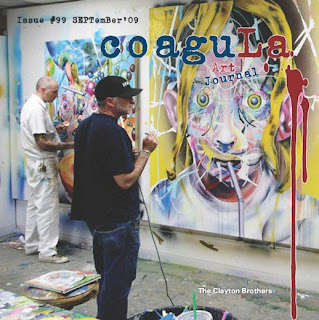

To help celebrate the 100th issue of Coagula Art Journal, I was invited to talk to publisher/editor/founder Mat Gleason about his art criticism and ideas.
Mat practices a bare knuckle critical style, sometimes reminiscent of his fellow westerners, Dave Hickey and Zane Fischer, and Robert Hughes at his most pugilistic. What he might lack in heavyweight credentials, he more than makes up for with some nifty footwork, a heart-on-sleeve doggedness and the occasional swift left jab.
The interview was conducted October 27-30, 2009, via email between my studio in Beacon, New York and Mat's Los Angeles base, and will be serialized in four parts over the next few days.
JW: You have a reputation as an art world maverick. Specifically, I've heard you say that in Los Angeles artists like you and galleries and institutions don't, and that that's reversed in New York. Could you shed some light on this phenomenon and would you say it has changed at all in your seventeen years publishing Coagula?
MG: It used to be primarily in New York that the artists would have a "Don't Rock The Boat" attitude, now that is in a lot of places. There is an attitude of artists that they are learning the ropes and are waiting in line for their turn and that any truly disruptive force to the art world is a threat to their investment of time into playing the game. Meanwhile the people at the top, they were not going anywhere so they loved a little challenge to the status quo, but nowadays they are way more uptight. What has happened is that there are actually fewer truly rich people at the top of the art world, so you have a whole group of people whose true power, their wealth, can be affected by getting fired from a museum job. So what HAS changed is that more people are in the art world to work and earn a living rather than to have fun and that makes any rabble rousing really frowned upon.
JW: What sort of relationship do you have with other art critics and with art criticism in general? Peter Schjeldahl once said to me, "Writing a check is very much more sincere than writing a review ...because it hurts ...you've got to mean it." Do you agree?
MG: We are all kind of scraping for the same crumbs so it is not generally a chummy lot - Since I created my vehicle and own it I am not in the "socialize to get gigs mode" that so many others are in. Sad fact is it doesn't pay that much, the gigs are few and far between and there are a lot of gray areas of morality about taking money to write catalogue essays, et cetera, and then add academia which is totally corrupt with helping colleagues who can get you tenure, and then add writers curating shows and having a back door to art world power and... I just stay the fuck out of other writer's business and keep my nose clean. Collectors are often way more passionate than critics, there is a jaded quality after you realize that even if you got hired by Art Forum, at the 20-year high school reunion you won't be as popular as the guy who runs an antique shop.
JW: I've heard you say that much so-called art is really craft, and that much art is just commerce or industry in disguise. Would you make a similar distinction between art and design, and do you see this and other boundaries blurring?
MG: Design is a sizzling trend at the moment and the hot core of this idea is that it can be as much a piece of fine art as anything else. And I reject that completely. Design, the idea of purity and an artwork being pure design, that is not where I am at in appreciating the effort of an artist. And design is so trendy, ephemeral and like a fashion that dates you if you wear it three years late. I like art that elevates a person's consciousness and design is wallpaper, and wallpaper elevates a room's consciousness at best.
To be continued.
Tomorrow, in Part Two, Mat reveals how artists can best describe their work, gets down and dirty about mysterious and mystical art, and goes for the jugular on the subject of beauty.
Issue #100 of Coagula Art Journal will be viewable November 10, online at Coagula.net.


















































